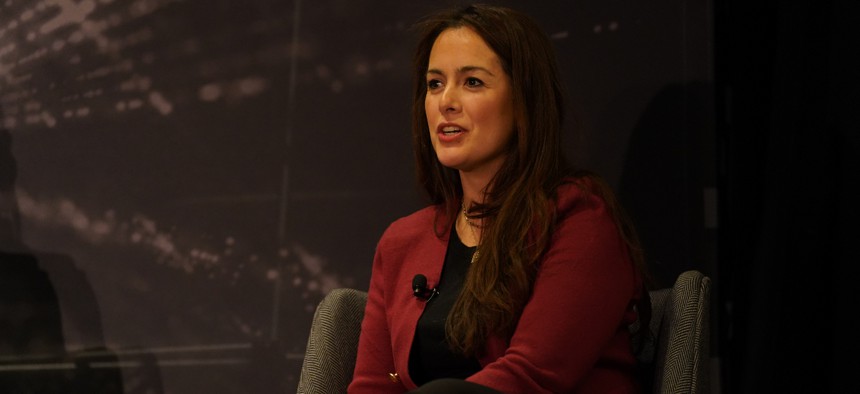How the Agriculture Department is ‘hardwiring’ customer experience into its work

USDA Chief Customer Experience Officer Simchah Suveyke-Bogin said her office is meant to be an enabler. Stephen Kaise/Staff
The department’s chief customer experience officer, Simchah Suveyke-Bogin, told Nextgov/FCW that her primary goal is building capacity for customer experience.
Simchah Suveyke-Bogin has a big job.
She’s been the Agriculture Department’s chief customer experience officer since 2020, leading the department’s office that is formally in charge of supporting a policy of “hardwiring, scaling and sustaining CX capabilities at USDA now and in the future,” per the 2022 permanent authorization of the office.
The goal is to make the department’s services better. Suveyke-Bogin says the Office of Customer Experience is meant to be an enabler.
The means: using an interdisciplinary human-centered design framework meant to address the problems people encounter when they’re trying to interact with the government — as opposed to rolling out policies, processes and tech shaped by the government’s own risk incentives, structures, etc.
Right now, Suveyke-Bogin’s biggest priority is capacity building, she told Nextgov/FCW in a recent interview.
“How can we create more capacity around human centered design? How can we encourage, but also support, agencies to do more service delivery like this?” she said. “How can we encourage, but also drive, folks to [learn] about their customers constantly?
“The motivation is really the service that we're delivering and that we're reaching the people that we need to reach,” she continued, “but to… operationalize that is very challenging, especially for services that have existed for so many decades.”
In terms of the actual customer experience office itself, USDA is looking for a $2 million increase to its budget in fiscal 2024 to bring the office to a $38 million total.
Part of capacity building is hiring staff to help with the work, and Suveyke-Bogin said she is working with the Office of Personnel Management on governmentwide hiring efforts — as well as those leading the President’s Management Agenda, the department’s own HR office and its chief information officer — to ensure the agency has the people capacity it needs.
The Biden administration’s 2023 budget request asks for money to hire over 120 new full-time employees to work on customer experience and digital product delivery across the Agriculture Department and 11 other agencies and departments.
And the Office of Personnel Management has a pooled hiring strategy to help fill positions needed across government, by offering lists of qualified candidates to multiple agencies. One forthcoming action under the pooled strategy intends to target IT product managers.
Another potential on-ramp is the creation of the Agriculture Department’s new digital services team.
Suveyke-Bogin explained that the department is looking for a mix of talent.
“It's not like one specific skill set and we're good,” she said. “We've been talking a lot about product managers, usability experts, data scientists, even folks who understand how to analyze feedback from customers really well.”
Capacity-building also means education around what customer experience work is and how to do it, especially in a large department where “everyone’s at a different maturity level when it comes to customer experience,” said Suveyke-Bogin.
“We’re civil servants, so everything we do is for the public, right?” she said, explaining how it can be hard to actually explain human-centered design. “But… there’s actually like disciplines dedicated to this.”
Both formalized training and hands-on customer experience work with different parts of the department will make up that education process, she said.
The office, for example, collaborated with the Farm Service Agency on a “deep dive” effort to research how people interact with the agency.
The agency has since improved the application process for its financing offerings for family farms. The overhaul cut the direct loan program application down from over 10 forms and 29 pages of paperwork to one 13-page document, according to a recent report from the Office of Information and Regulatory Affairs.
In addition to an online assistance tool, the department is expecting to launch online, paperless application and repayment options this year.
The department has also been working on a “voice of the customer” initiative to gather feedback on its programs. A recent public update on the department’s customer experience work acknowledged that the department “does not have a consistent feedback framework for customer listening and feedback.”
In figuring out how exactly to formalize the reorientation around outcomes and experiences of the people using services themselves, one thing Suveyke-Bogin has had to navigate is the breadth of the department — over the 29 agencies and offices and nearly 100,000 employees.
“All of our services are different sizes. They reach different communities… It’s really hard to write just like one policy that everyone is going to just do it the exact same way,” she said.
It’s a tightrope. Her office is trying “to be an enabler, and not make it harder, but [also] recognize the importance that we should be doing it.”
Technically, some of the department’s services are also delivered via states, like the Supplemental Nutrition Assistance Program, or SNAP. That cross-government nature of many USDA programs is a good example of how cross-cutting customer experience can be, said Suveyke-Bogin.
“It doesn’t fit perfectly in a box,” she said, explaining that customer experience is often viewed in the context of technology, though it also impacts policy, grantmaking and what the government asks of customers.
“There's always so many layers as to how our actions determine other actions, [and] that's ultimately going to impact the person at the end of it,” Suveyke-Bogin said. “We just always have to look — absolutely at how it impacts technology and our technology efforts — but also policy, processes and even our internal workflow — like how we're how we have organized ourselves internally or operationally — because it usually ultimately impacts how the public sees us or how they feel [about] what we're doing on their behalf.”
NEXT STORY: IRS seeks states’ input on its direct file pilot






